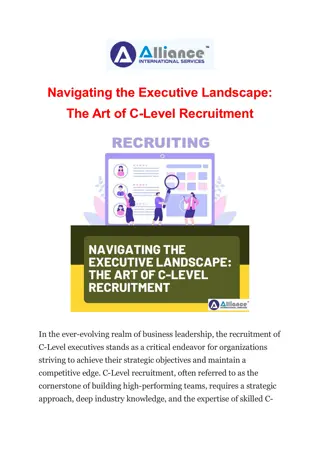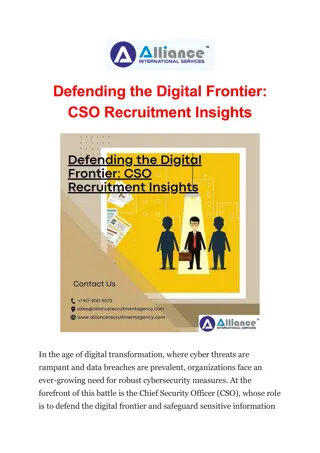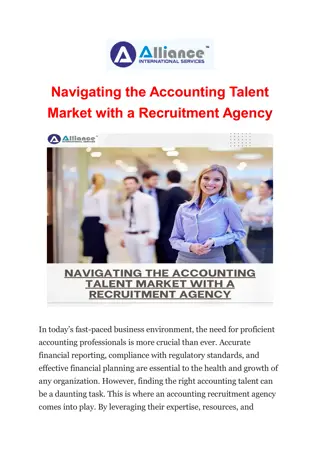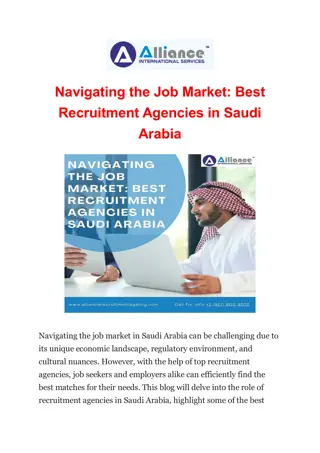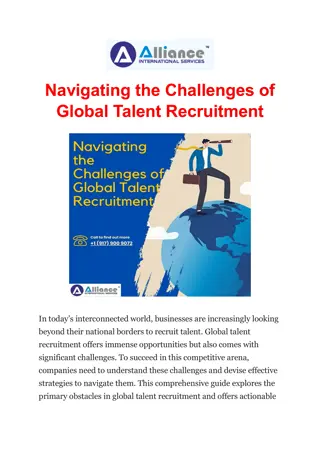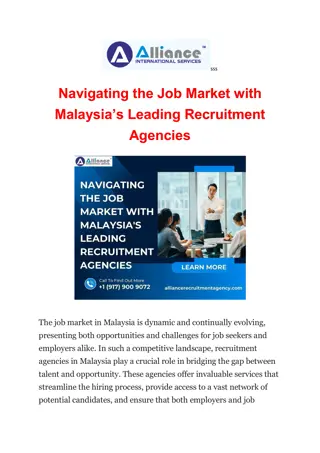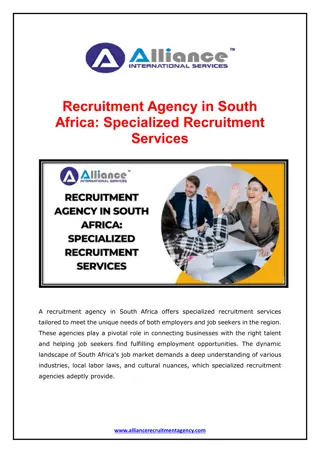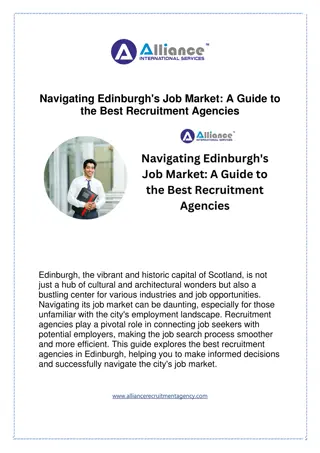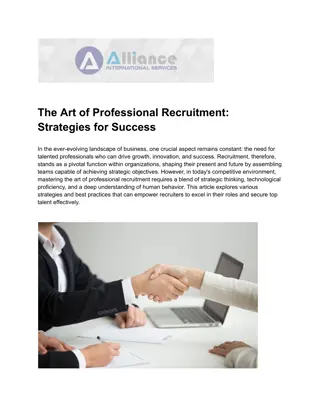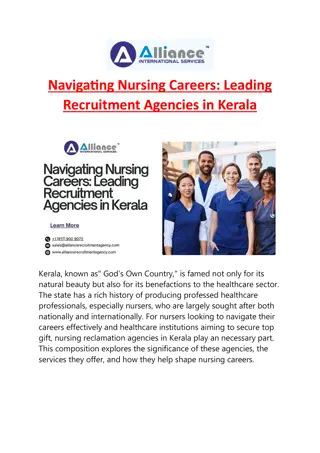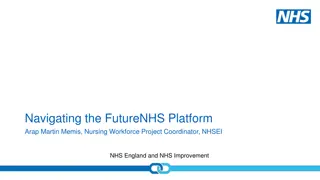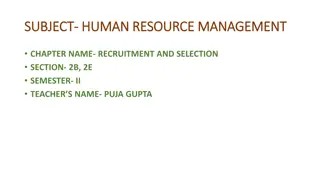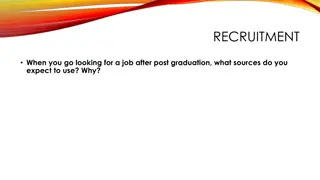
Navigating the Depths of Recruitment in Human Resource Management A Comprehensive Guide
Unlock the secrets of effective talent acquisition with our in-depth exploration of recruitment in human resource management. From sourcing strategies to selection techniques, discover how to build a high-performing team that drives organizational success.
Download Presentation

Please find below an Image/Link to download the presentation.
The content on the website is provided AS IS for your information and personal use only. It may not be sold, licensed, or shared on other websites without obtaining consent from the author. If you encounter any issues during the download, it is possible that the publisher has removed the file from their server.
You are allowed to download the files provided on this website for personal or commercial use, subject to the condition that they are used lawfully. All files are the property of their respective owners.
The content on the website is provided AS IS for your information and personal use only. It may not be sold, licensed, or shared on other websites without obtaining consent from the author.
E N D
Presentation Transcript
Navigating the Depths of Recruitment in Human Resource Management: A Comprehensive Guide In the ever-evolving landscape of business, one aspect remains constant: the critical role of recruitment in human resource management. In today's competitive market, finding and retaining top talent is paramount to an organization's success. Recruitment, as a cornerstone of HRM, encompasses a vast array of strategies, techniques, and challenges. In this comprehensive guide, we delve into the intricacies of Recruitment in Human Resource Management, exploring its significance, best practices, and emerging trends. https://www.alliancerecruitmentagency.com
Understanding the Significance of Recruitment in HRM Recruitment serves as the gateway to an organization's talent pool, influencing its performance, culture, and overall success. In the realm of HRM, effective recruitment goes beyond filling vacant positions; it involves strategic planning aligned with organizational goals and values. A robust recruitment process not only attracts qualified candidates but also fosters diversity, innovation, and long-term growth. The Recruitment Process: A Step-by-Step Approach Identifying Talent Needs: The first step in recruitment is understanding the organization's current and future talent requirements. This involves collaborating with hiring managers, analyzing job roles, and forecasting staffing needs. Strategic Planning: Crafting a recruitment strategy tailored to the organization's objectives is crucial. This includes defining target candidate profiles, selecting appropriate sourcing channels, and establishing timelines and metrics for evaluation. Sourcing Candidates: Recruitment channels vary from traditional methods such as job boards and referrals to modern approaches like social media and talent platforms. Leveraging a diverse range of channels ensures a broader reach and access to a varied talent pool. Screening and Selection: Screening candidates involves assessing their qualifications, skills, and cultural fit through resumes, interviews, and assessments. Selecting the most suitable candidates entails aligning their competencies with the job requirements and organizational culture. Onboarding and Integration: Once selected, effective onboarding is crucial for new hires to acclimate to the organization's culture, values, and processes smoothly. A structured onboarding program facilitates faster integration and enhances employee engagement and retention. Best Practices in Recruitment Employer Branding: Building a strong employer brand enhances the organization's reputation and attractiveness to potential candidates. Consistent messaging, positive employee experiences, and transparent communication contribute to a compelling employer brand. https://www.alliancerecruitmentagency.com
Candidate Experience: Providing a positive candidate experience is essential, regardless of the outcome. Clear communication, timely feedback, and respectful treatment leave a lasting impression and can influence candidates' perceptions of the organization. Data-Driven Decision-Making: Leveraging data and analytics in recruitment enhances decision-making and improves efficiency. Metrics such as time-to-fill, cost-per-hire, and quality-of-hire provide insights into the effectiveness of recruitment strategies and areas for improvement. Diversity and Inclusion: Promoting diversity and inclusion in recruitment fosters innovation, creativity, and a broader perspective within the organization. Implementing unbiased hiring practices, diverse sourcing channels, and inclusive language in job descriptions are vital steps towards building a diverse workforce. Continuous Improvement: Recruitment is an iterative process that requires continuous evaluation and refinement. Gathering feedback from stakeholders, analyzing recruitment metrics, and adapting strategies to changing market dynamics ensure ongoing improvement and optimization. Emerging Trends in Recruitment Artificial Intelligence (AI) and Automation: AI-powered tools and automation streamline various aspects of the recruitment process, from resume screening to candidate engagement. Chat bots, predictive analytics, and video interviewing platforms enhance efficiency and reduce time-to-hire. Remote and Flexible Work: The rise of remote work has expanded the geographical scope of recruitment, enabling organizations to tap into talent pools beyond traditional boundaries. Flexibility in work arrangements has become a significant factor in attracting and retaining top talent. Candidate-Centric Approach: Organizations are shifting towards a candidate-centric approach, focusing on personalized experiences and engagement throughout the recruitment process. Tailored communication, virtual events, and interactive assessments prioritize candidates' needs and preferences. Skills-Based Hiring: With rapid technological advancements, the focus is shifting from traditional credentials to skills and competencies. Skills-based hiring emphasizes the assessment of candidates' abilities, potential, and adaptability to meet evolving job requirements. https://www.alliancerecruitmentagency.com
Remote Onboarding: As remote work becomes prevalent, remote onboarding processes are gaining prominence. Virtual orientation sessions, digital training modules, and online mentoring facilitate a seamless transition for new hires, irrespective of their location. Conclusion Recruitment in human resource management is a multifaceted endeavor that requires strategic vision, innovative approaches, and a deep understanding of organizational dynamics. By embracing best practices, leveraging emerging trends, and prioritizing candidate experience, organizations can build a robust recruitment framework that drives sustainable growth and competitive advantage. As recruitment continues to evolve in response to changing demographics, technologies, and market dynamics, staying agile and adaptable is paramount for success in the dynamic world of HRM. Alliance Recruitment Agency: Alliance Recruitment Agency is a leading Global Manpower Agency specializing in recruitment in human resource management. With a proven track record of connecting organizations with top talent worldwide, we offer comprehensive HR solutions tailored to meet diverse staffing needs. Whether you're seeking executive search services, temporary staffing, or workforce solutions, Alliance Recruitment Agency is your trusted partner for recruiting success. Contact Us today to elevate your recruitment strategy and unlock the full potential of your workforce. https://www.alliancerecruitmentagency.com
CONTACT US Alliance Recruitment Agency Mobile No: +19179009072 Email: sales@alliancerecruitmentagency.com Address: 104 Esplanade ave120 Pacific, CA 94044 Website: https://www.alliancerecruitmentagency.com/ https://www.alliancerecruitmentagency.com





